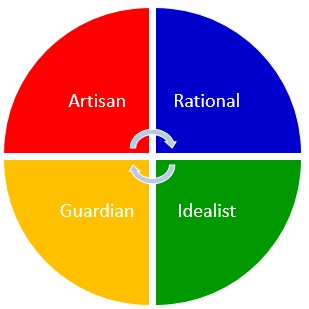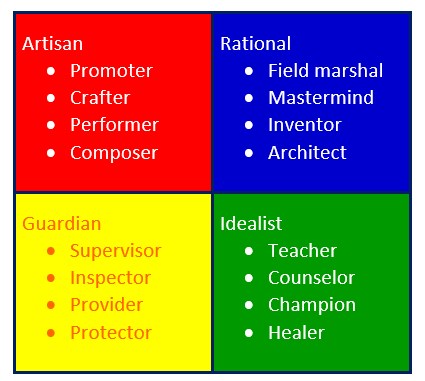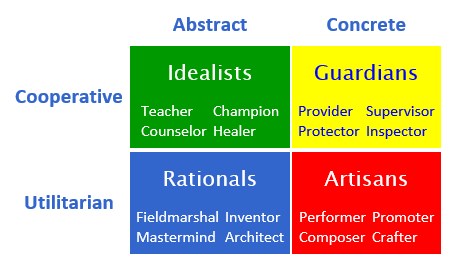Keirsey Temperaments
David Keirsey’s four temperaments are related to personality types. They are based on the theory that human beings come in four basic patterns.
According to Keirsey’s theory, there are four basic temperament groups which describe human behavior. Essentially, Keirsey divided all of humanity into four key temperamental groups. Each temperament has its own unique qualities, shortcomings, strengths and challenges.
Keirsey’s four temperaments:
- Artisan
- Guardian
- Idealist
- Rational
About Temperament
Keirsey defines temperament as a configuration of observable personality traits, such as the habits of communication, patterns of action, and sets of characteristic attitudes, values, and talents. It also encompasses personal needs, the kinds of contributions that individuals make in the workplace, and the roles they play in society.
History of Personality Classifications and Temperaments
Keirsey’s personality groups are not new. Various personality classifications, personality dimensions, or temperament have been proposed for over 2,000 years. Keirsey’s personality groups represent key human archetypes found throughout history. Keirsey expanded on the study of temperament by Hippocrates and Plato. Actually, the names of the classes were the same as suggested by Plato.
Sixteen Types
Keirsey divided the four temperaments into two categories (roles), each with two types (role variants). Hence, there are four types of Artisans, four types of Guardians, four types of Rationals, and four types of Idealists. This makes up for 16 types in total.
Artisans
- Composer
- Crafter
- Performer
- Promoter
Guardians
- Inspector
- Protector
- Provider
- Supervisor
Idealists
- Champion
- Counselor
- Healer
- Teacher
Rationals
- Architect
- Fieldmarshal
- Inventor
- Mastermind
Correlation to Myers and Briggs
The four classification of temperaments sub-classified into sixteen character types are based on introversion versus extraversion, thinking versus feeling, judging and perceiving, and sensation versus intuition. The resulting 16 types closely correlate with the 16 personality types described by Briggs and Myers
Keirsey himself has drawn a correlation between the four temperaments and the work of Myers and Briggs. He found that certain types that were described by Myers and Briggs corresponded closely to the four temperaments. Using the letter descriptors from the MBTI, the correlations are as follows:
Artisans = SP
Guardians = SJ
Rationals = NT
Idealists = NF
About Keirsey Temperaments
Keirsey’s describes each temperament for their natural talents, interests, self-concepts, values, and behavioral orientations.
Guardians
- They are concrete and organized.
- They are generally concerned with responsibility and duty.
- They seek security and belonging.
- They tend to be hard-working, dependable, loyal, stable, and responsible.
- They tend to be cautious and concerned with maintaining tradition.
- Their greatest strength is logistics.
- They excel at organizing, facilitating, checking, and supporting.
Idealists
- They are abstract, cooperative, and compassionate.
- They are generally concerned with personal growth and finding their own unique identity.
- They seek meaning and significance.
- They tend to be enthusiastic, intuitive, romantic, truth-seeking, kind, inspiration, and authentic.
- They tend to seek self-knowledge, self-understanding, and strive to achieve their ultimate potential.
- Their greatest strength is diplomacy.
- They excel at clarifying, individualizing, unifying, and inspiring.
Artisans
- They are concrete and adaptable.
- They are optimistic, realistic, bold, spontaneous, and focused on the here-and-now.
- They are generally concerned with making an impact.
- They seek stimulation and virtuosity.
- Their greatest strength is tactics.
- They excel at troubleshooting, agility, and the manipulation of tools, instruments, and equipment.
Rationals
- They are abstract, objective, and pragmatic.
- They are generally concerned with their own knowledge and competence.
- They seek mastery and self-control.
- They tend to be pragmatic, independent, strategic, and skeptical.
- Their greatest strength is strategy.
- They excel in any kind of logical investigation such as engineering, conceptualizing, theorizing, and coordinating.
Keirsey Temperament Sorter
The Keirsey Temperament Sorter (KTS) is a self-assessed personality questionnaire designed to help people discover their temperament. It was first introduced in his book “Please Understand Me” and is one of the most widely used personality instrument.
The Temperament Sorter is a 70 question personality instrument that helps individuals discover their personality type. The questions are designed to sort between four dichotomous pairs of preferences, leading to results which reveal a person’s temperament and character type. It closely associated with the Myers-Briggs Type Indicator (MBTI).



